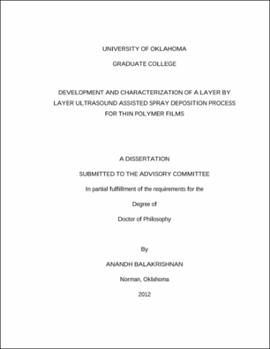| dc.contributor.advisor | Saha, Mrinal C | |
| dc.creator | Balakrishnan, Anandh | |
| dc.date.accessioned | 2019-04-27T21:25:46Z | |
| dc.date.available | 2019-04-27T21:25:46Z | |
| dc.date.issued | 2012 | |
| dc.identifier | 99181360602042 | |
| dc.identifier.uri | https://hdl.handle.net/11244/318653 | |
| dc.description.abstract | An Ultrasound assisted Atomization (UA) system has been developed and investigated to synthesize ~20µm polyurethane thin films with uniform, repeatable thickness and microstructure. The UA system comprised a 20 kHz atomizer probe mounted on 750 W/cm2 transducer, a heated glass chamber and a rotating substrate. The rationale for the work has been built through a careful Design of Experiments (DoE) that sought to answer questions regarding the process-microstructure relationships from both the spray and material points of view. The independent variables chosen were the polymer solution weight percentage (0.2%, 2%, and 4%), power amplitude (energy) percentage supplied to the nozzle (23%, 29%, 37%, and 46%),the temperature of deposition (45°C, 80°C) and flow rate (50µL/min, 150µL/min). | |
| dc.description.abstract | The research questions focused on influence of the process parameters on the microstructure and properties of the film. One of the problems involved fixing the trajectory of the spray and also making use of the droplet surfaces created by the spray. To achieve this, a simple air-draft attachment was devised and the influence of the same was evaluated through process and film characterization experiments. A mechanism for the draft has been schematically provided. The use of such a draft to fabricate thin polymer films via ultrasound atomization has not been achieved before and represents a `first step' in advancing this ultrasound technology. | |
| dc.description.abstract | The primary findings of the work were that the film microstructure and properties were heavily influenced by the flow rate, energy of atomization, and test temperature. In addition, the droplet diameters seemed to be readily amenable to change for the 0.2 and 2% solutions and the use of the air-draft made the process feasible, repeatable and accurate. For the 4% solutions, viscosity seemed to stabilize the liquid solution film at the tip requiring larger energies of atomization. | |
| dc.description.abstract | In all, relative to the 0.2% films the fracture strengths, strains and toughness values had improved vastly for 4% and 2%. | |
| dc.description.abstract | Calorimetric, Small Angle X-ray scattering and Atomic Force Microscopy (AFM) measurements showed a largely phase mixed hard segment-soft segment morphology. Calorimetry showed that the 0.2% specimens showed higher melting points (between 110-130°C) indicative of greater hard domain ordering in these samples. This is not evident in the 2% and 4% samples. This trend is supported by the Small Angle X-ray scattering and AFM data. The X-ray data show larger domain sizes and greater invariants for the 0.2% samples relative to the 2% and 4% samples. The AFM phase image measurements provided hard domain widths in the same range as the X-ray measurements (10-11 nm). All of the topographical trends from AFM showed that surface morphology was affected by i) increasing atomization energies from 29%-46% of energy (decreased surface roughness from 3 nm to 2 nm for 2% films and 1 nm to 0.5 nm for 4% films) ; ii) increasing film fabrication temperature from 45°C-80°C (increased roughness from 3nm to 4-5nm in local spots for 2% films and from 0.5nm to 0.6 nm for 4% films), iii) decreasing flow rate of the pump from 150µL/min to 50µL/min (comparable roughness for the case of the 2% films from 3nm to 2nm). These could explain the trends in mechanical responses as a f( energy of atomization and temperature). | |
| dc.description.abstract | In order to examine sample crystallinity, we performed Wide Angle X-ray Scattering which showed a fully amorphous polymer structure. The lack of any reflections indicated that the melting points observed from calorimetry were not due to long range order in the material but due to pseudo crystalline behavior. This behavior could be ascribed to the formation of urethane-urethane ordering with hydrogen bonds between them. In general, ultrasonic energy of the capillary wave causes phase mixing and the extent of phase mixing was dependent on the weight percentage of polymer solution and the type of solvent. It was highest for the 4% samples and lowest for the 0.2% samples. | |
| dc.format.extent | 199 pages | |
| dc.format.medium | application.pdf | |
| dc.language | en_US | |
| dc.relation.requires | Adobe Acrobat Reader | |
| dc.subject | Thin films | |
| dc.subject | Ultrasonic waves | |
| dc.subject | Polymers | |
| dc.title | Development and Characterization of a Layer By Layer Ultrasound Assisted Spray Deposition Process for Thin Polymer Films | |
| dc.type | text | |
| dc.type | document | |
| dc.thesis.degree | Ph.D. | |
| ou.group | College of Engineering::School of Aerospace and Mechanical Engineering | |
